Effect of Different Nitrogen Fertilizer Application Strategies on Rice Growth and Yield
, , , , ,
1. Liaoning Saline or Alkaline Land Utilization and Research Institute, Panjin 124010, China; 2.Affiliated Experimental Farm of Shenyang Agricultural University, Shenyang 110161, China
EffectofDifferentNitrogenFertilizerApplicationStrategiesonRiceGrowthandYield
DongJIA1*,JingjingLU1,YajunSUN1,ShuangSONG1,HanDU1,LeiHAN2
1. Liaoning Saline or Alkaline Land Utilization and Research Institute, Panjin 124010, China; 2.Affiliated Experimental Farm of Shenyang Agricultural University, Shenyang 110161, China
Nitrogen fertilizer is an important factor for crop production. The N application strategies named as former nitrogen moved backward (FNMB) are tested in three ecological regions to optimize the N application in rice. The dry matter accumulation and distribution, yield and quality are studied to understand the formation of yield and quality of rice under different N application strategies. The result indicates that former nitrogen moved backward (FNMB) can increase tiller number and dry matter accumulation; effective ears and yield can be increased with the increase of fertilization; rational nitrogen application can help to establish scientific group structure, harmonize yield component, and then achieve high ratio of input to output and benefit.
Rice, Nitrogen fertilizer, Operation research, Former nitrogen moved backward (FNMB), Dry matter accumulation, Yield
1 Introduction
China is a major rice producer and consumer in the world and the total rice production is ranked first in the world. In terms of rice growing area, China is second only to India, and China has a population of more than two thirds with rice as the staple food[1]. However, the consumption of nitrogen fertilizer is too high in the current rice production, and especially at the early stage, the large nitrogen fertilizer application proportion is very prominent. Clearly understanding the regulatory mechanisms of different nitrogen fertilizer application strategies on rice production is of great significance to improving nitrogen use efficiency in rice production and maintaining sustainable development of rice. Nitrogen is one of the three elements necessary for the growth of rice, and the use of nitrogen fertilizer has obvious effect on the growth of rice[2]. In the traditional agricultural production, due to the blind pursuit of economic efficiency, the crop fertilization is mainly based on application of nitrogen fertilizer, lacking balanced fertilization technology, resulting in waste of fertilizer and increase of crop production costs. And the surface runoff, ammonia volatilization and drainage cause groundwater pollution, eutrophication, greenhouse gas emissions and many other negative environmental effects[3]. With declining arable land and population growth, the conflicts between depletion of resources and food security or environmental protection become increasingly prominent, largely related to unreasonable and excessive application of nitrogen fertilizer[4]. Farmers have long entertained the misconception that more fertilizers will lead to higher yield, resulting in increasing application of nitrogen fertilizer in the intensive farming areas, and making the crop fertilization amount exceed crop uptake[5]. Therefore, under the premise of guaranteeing high rice yield, how to protect the environment and improve the use efficiency of nitrogen in rice is currently a scientific issue to be solved in China, and it is important to the sustainable development of rice production[6]. In this paper, using different nitrogen application strategies, we study the dynamic rice growth, nitrogen use and production change, in order to guide rice production.
2 Materials and methods
2.1ExperimentaldesignThe experiment was carried out in the experimental plot of Liaoning Saline or Alkaline Land Utilization and Research Institute in 2012. The soil fertility is moderate, and the main rice varieties Yanfeng 47 and Yanjing 188 in Liaoning coastal rice-growing areas are selected as test materials. Three nitrogen fertilizer levels are set: N1, pure nitrogen 165 kg/ha; N2, pure nitrogen 210 kg/ha; N3, pure nitrogen 255 kg/ha. The treatment N0in non-nitrogenous fertilizer area is regarded as blank control. 3 fertilization ratios are set at each nitrogen fertilizer level (basal and tillering fertilizer: panicle fertilizer), namely F1,8∶2;F2,7∶3;F3,6∶4. The split-plot design is adopted, with the treatment of nitrogen fertilizer level and nitrogen fertilizer application proportion as main plot, and variety as subplot. The rice transplanting specification is 30.0 cm×13.3 cm, 3 seedlings per hill, repeated three times, a total of 30 plots. The plot area is 19.35 m2(4.5 m long, 4.3 m wide), 8 rows per variety, a total of 16 rows. P and K content under all treatments is based on N2treatment (N∶P2O5∶K2O=2∶1∶1), and the application rate is the same. 46% of urea in nitrogen fertilizer is applied on rice four times (base fertilizer; tillering fertilizer; earing fertilizer; granular fertilizer). For basal and tillering fertilizer, 60% is as base fertilizer and 40% is as tillering fertilizer; for panicle fertilizer, 60% is as earing fertilizer and 40% is as granular fertilizer. 100% of superphosphate as basal fertilizer is applied, and 50% of potassium sulfate is applied as base fertilizer and earing fertilizer, respectively. The experiment uses seedling transplanting, and chooses single-season japonica rice for planting. Ridging, irrigation and drainage are conducted separately in each plot.
2.2Determinationindicators
2.2.1Dynamic state of tiller. From tillering stage to booting stage, the tiller number is investigated at intervals of 7 d, and 10 hills are taken as survey points.
2.2.2Dry matter accumulation and yield determination. At heading and maturity stages, 6 hills of representative plants are selected in each plot, and the plants are uprooted and cleaned. The blades, stems and ears are separated, and go through deactivation of enzymes in hot air oven at 105 ℃ for 30 min. They are dried at 80℃ for 48-72 h, and then weighed. At maturity stage, the number of available ears is investigated at the points where tiller number is investigated. 6 m2of plants are harvested, dried and thre-shed to calculate the production. In addition, 4 representative hills are selected in each plot, and after air drying indoors, the grain number, thousand-grain weight and maturing rate are measured.
2.2.3Determination of nitrogen use rate. The dried leaves, stems and ears are crushed and sieved respectively, and Kjeldahl method is used to measure the nitrogen content.
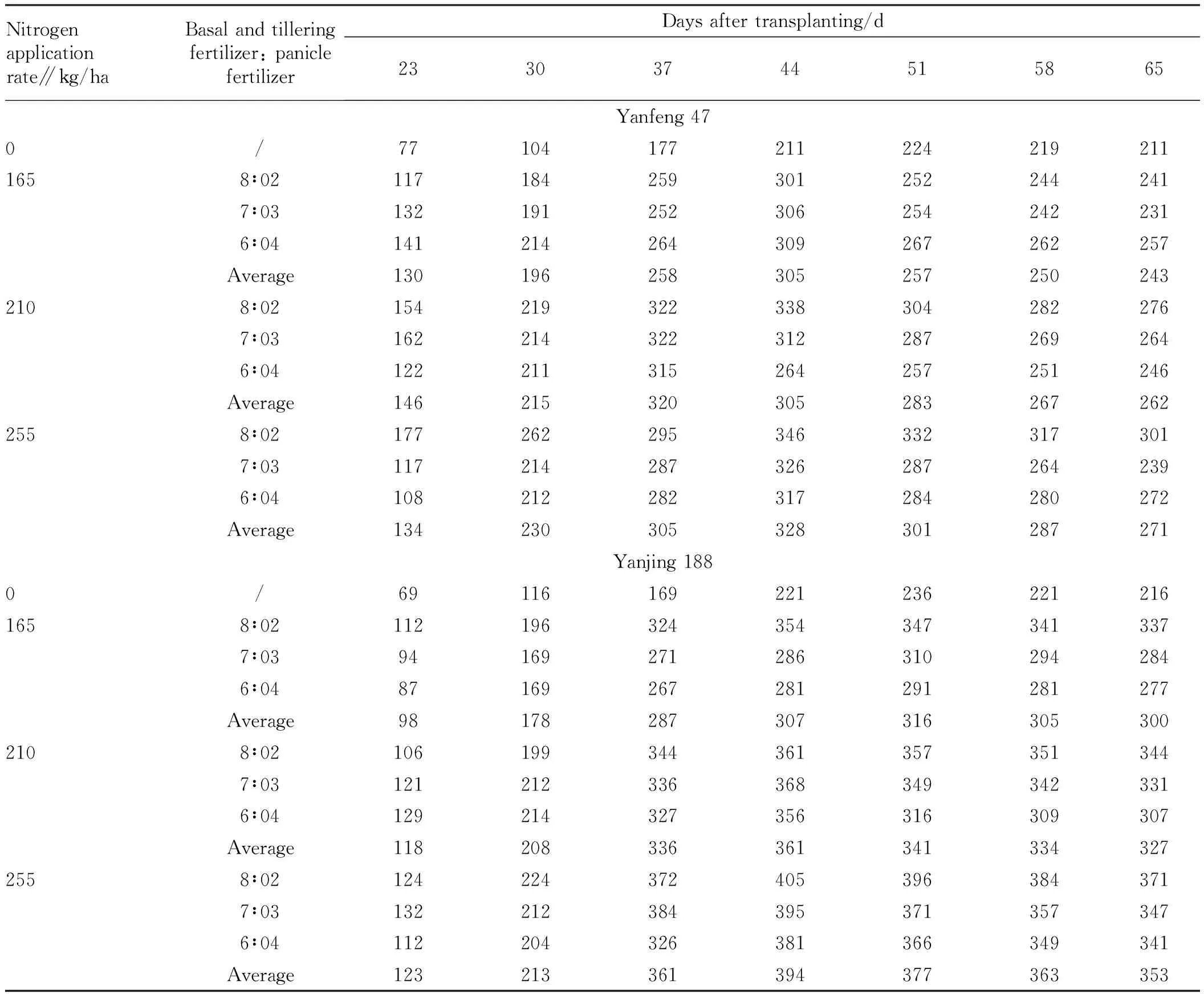
Table 1 Effect of different nitrogen fertilizer application strategies on the tiller number of Yanfeng 47 and Yanjing 188 Unit: 104/ha
3 Results and analysis
3.1EffectofdifferentnitrogenfertilizerapplicationstrategiesontillerNitrogen application can increase the tiller number of Yanfeng 47. On the 23rdd and 37thd after transplanting, it is largest under the nitrogen application treatment of 210 kg/ha, and in other periods, the nitrogen application treatment of 255 kg/ha holds an advantage (Table 1). Under the pure nitrogen application treatment of 165 kg/ha, when the proportion of basal and tillering fertilizer and panicle fertilizer is 8∶2, 7∶3 and 6∶4, the highest tillering critical period is the 44thd after transplanting, and the tiller number is largest (3090000 tillers/ha) when the proportion is 6∶4. Under the pure nitrogen application treatment of 210 kg/ha, when the proportion is 8∶2, the largest tiller number is 3380000 per ha, and the highest tillering critical period is the 44thd after transplanting. When the proportion is 7∶3 and 6∶4, the highest tillering critical period is the 37th d after transplanting. Under the pure nitrogen application treatment of 255 kg/ha, when the proportion of basal and tillering fertilizer and panicle fertilizer is 8∶2, 7∶3 and 6∶ 4, the highest tillering critical period is the 44thd after transplanting, and when the proportion is 8:2, the tiller number is largest, reaching 3460000 per ha. From the 23rdd to 65thd after transplanting, the tiller number of Yanjing 188 increases with the increasing nitrogen application rate. Under the pure nitrogen application treatment of 165 kg/ha, when the proportion of basal and tillering fertilizer and panicle fertilizer is 8∶2, the highest tillering critical period is the 44thd after transplanting, and the largest tiller number is 3540000 per ha. When the proportion is 7∶3 and 6∶4, the highest tillering critical period is the 51std after transplanting. Under the pure nitrogen application treatment of 210 kg/ha, when the proportion of basal and tillering fertilizer and panicle fertilizer is 8∶ 2, 7∶ 3 and 6∶ 4, the highest tillering critical period is the 44thd after transplanting, and when the proportion is 7:3, the tiller number is largest, reaching 3690000 per ha. Under the pure nitrogen application treatment of 255 kg/ha, when the proportion of basal and tillering fertilizer and panicle fertilizer is 8∶ 2, 7∶ 3 and 6∶ 4, the highest tillering critical period is the 44thd after transplanting, and when the proportion is 8∶ 2, the tiller number is largest, reaching 4050000 per ha. Through comprehensive analysis, it is found that under the high nitrogen treatment for the two rice varieties, when the proportion of basal and tillering fertilizer and panicle fertilizer is 8∶ 2, we can get large tiller number.
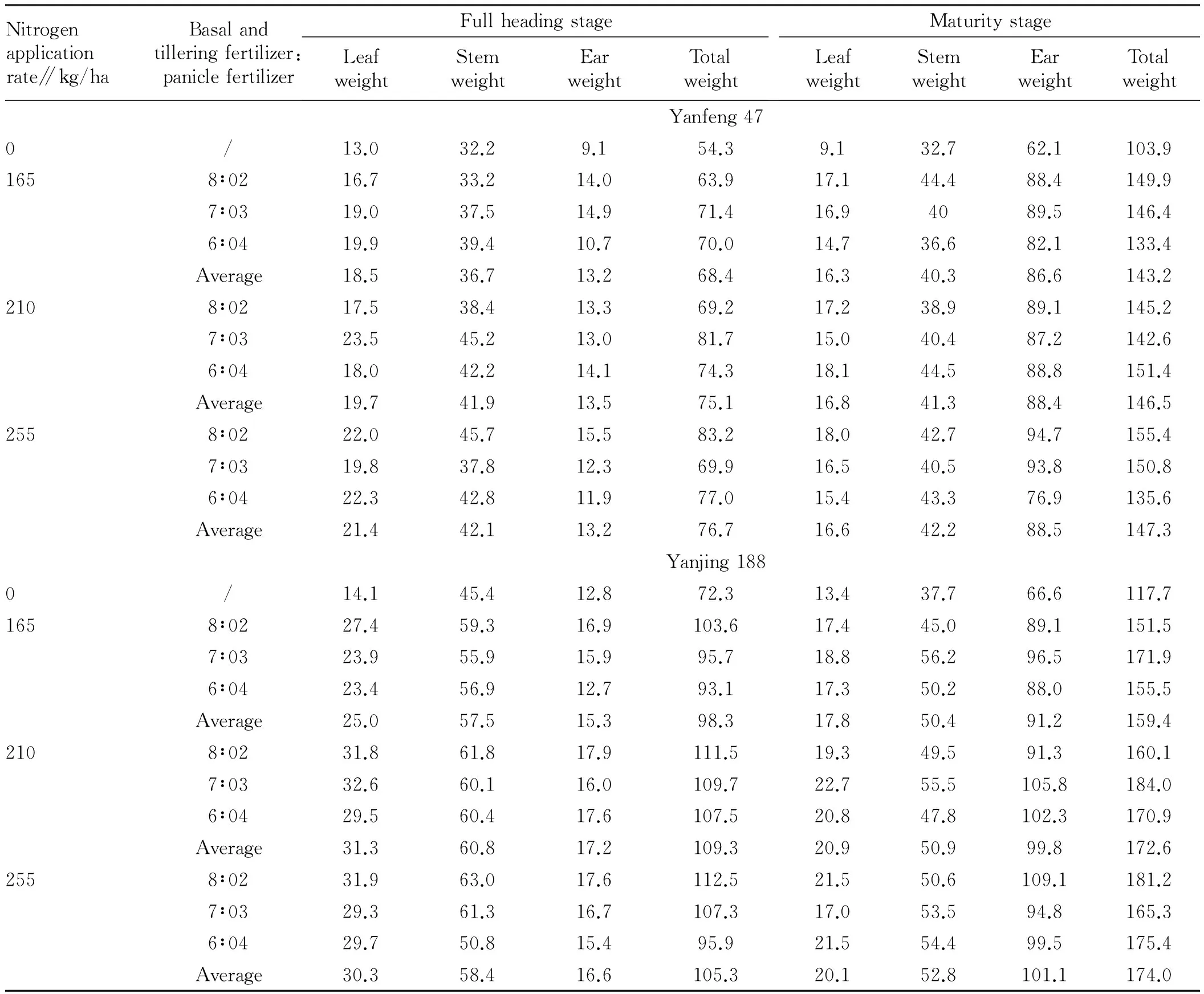
Table 2 Effect of different nitrogen fertilizer application strategies on accumulation of dry matter Unit: 100 kg/ha
3.2EffectofdifferentnitrogenfertilizerapplicationstrategiesonaccumulationofdrymatterAt the full heading stage, the leaf dry weight, stem dry weight and total dry weight of Yanfeng 47 show an increasing trend with the increasing nitrogen application while the ear dry weight increases first and then decreases. At the maturity stage, stem dry weight, ear dry weight and total dry weight show an increasing trend, while leaf dry weight increases first and then decreases. Under the pure nitrogen application treatment of 165 kg/ha, when the proportion of basal and tillering fertilizer and panicle fertilizer is 6∶ 4, the leaf dry weight and stem dry weight at the full heading stage can be increased while the leaf dry weight, stem dry weight, ear dry weight and total dry weight at the maturity stage are all lowest; when the proportion is 7∶3, the ear dry weight and total dry weight at the full heading stage as well as the ear weight at the maturity stage can be increased; when the proportion is 8∶2, the leaf dry weight, stem dry weight and total dry weight at the maturity stage can be increased. Under the pure nitrogen application treatment of 210 kg/ha, when the proportion of basal and tillering fertilizer and panicle fertilizer is 6∶ 4, the ear dry weight at the full heading stage and leaf dry weight, stem dry weight and total dry weight at the maturity stage can be increased; when the proportion is 7∶3, the stem dry weight, leaf dry weight and total dry weight at the full heading stage can be increased, but at the maturity stage, the dry weight of different organs is relatively low; when the proportion is 8∶2, the ear dry weight at the maturity stage can be increased. Under the pure nitrogen application treatment of 255 kg/ha, when the proportion of basal and tillering fertilizer and panicle fertilizer is 6∶ 4, the leaf dry weight at the full heading stage and stem dry weight at the maturity stage can be increased; when the proportion is 7∶3, the dry weight of different organs is relatively low at the full heading stage, and it increases at the maturity stage; when the proportion is 8∶2, the stem dry weight, ear dry weight and total dry weight at the full heading stage can be increased, and the leaf dry weight, stem dry weight, ear dry weight and total dry weight at the maturity stage can be also increased. With the increasing application of nitrogen, the leaf dry weight, stem dry weight, ear dry weight and total dry weight of Yanjing 188 at the full heading stage increase first and then decrease; the stem dry weight, ear dry weight and total dry weight at the maturity stage show an increasing trend, while the leaf dry weight increases first and then decreases. Under the pure nitrogen application treatment of 165 kg/ha, when the proportion of basal and tillering fertilizer and panicle fertilizer is 6∶ 4, the dry matter of various organs at the maturity and full heading stages does not hold an advantage; when the proportion is 7∶3, the leaf dry weight, ear dry weight and total dry weight at the maturity stage can be increased; when the proportion is 8∶2, the leaf dry weight, ear dry weight, stem dry weight and total dry weight at the full heading stage can be increased, while it does not preponderate at the maturity stage. Under the pure nitrogen application treatment of 210 kg/ha, when the proportion of basal and tillering fertilizer and panicle fertilizer is 6∶ 4, the dry matter of various organs at the maturity and full heading stages does not hold an advantage; when the proportion is 7∶3, the leaf dry weight at the full heading stage and the leaf dry weight, ear dry weight, stem dry weight and total dry weight at the maturity stage can be increased; when the proportion is 8∶2, the ear dry weight, stem dry weight and total dry weight at the full heading stage can be increased, while it does not preponderate at the maturity stage. Under the pure nitrogen application treatment of 255 kg/ha, when the proportion of basal and tillering fertilizer and panicle fertilizer is 6∶ 4, the leaf dry weight and stem dry weight at the maturity stage can be increased; when the proportion is 7∶3, the dry matter of various organs at the maturity and full heading stages is relatively low; when the proportion is 8∶2, the leaf dry weight, ear dry weight, stem dry weight and total dry weight at the full heading stage and the ear dry weight and total dry weight at the maturity stage can be increased. In summary, there are some differences in the reaction of the two varieties to nitrogen, and high nitrogen promotes Yanfeng 47 but has a negative effect on Yanjing 188. By increasing the proportion of panicle fertilizer, the dry weight of leaf and stem can be increased.
3.3EffectofdifferentnitrogenfertilizerapplicationstrategiesonyieldanditscomponentsAs can be seen from Table 3, with increasing application of fertilizer, the ear length of Yanfeng 47 shows a decreasing trend; yield and effective panicle number show an increasing trend; grain number per panicle, thousand-grain weight and maturing rate increase first and then decrease; the percentage of ear-bearing tiller decreases first and then increases. Under the pure nitrogen application treatment of 165 kg/ha, when the proportion of basal and tillering fertilizer and panicle fertilizer is 6∶ 4, the effective panicle number can be increased; when the proportion is 7∶3, the thousand-grain weight and maturing rate can be increased; when the proportion is 8∶2, the grain number per panicle and percentage of ear-bearing tiller can be increased. Under the pure nitrogen application treatment of 210 kg/ha, when the proportion of basal and tillering fertilizer and panicle fertilizer is 6∶ 4, the thousand-grain weight and grain number per panicle can be increased; when the proportion is 7∶3, various yield components are in a middle state; when the proportion is 8∶2, the effective panicle number can be increased. Under the pure nitrogen application treatment of 255 kg/ha, when the proportion of basal and tillering fertilizer and panicle fertilizer is 6∶ 4, the thousand-grain weight can be increased; when the proportion is 7∶3, the maturing rate can be increased; when the proportion is 8∶2, the effective panicle number and grain number per panicle can be increased. The actual yield of Yanfeng 47 is highest (9269.8 kg/ha) under the pure nitrogen application treatment of 255 kg/ha when the proportion of basal and tillering fertilizer and panicle fertilizer is 8∶2, followed by the yield (9131.2 kg/ha) under the pure nitrogen application treatment of 210 kg/ha when the proportion of basal and tillering fertilizer and panicle fertilizer is 6∶4, with little difference between the two. With increasing application of nitrogen fertilizer, the grain number per panicle and maturing rate of Yanjing 188 show a decreasing trend, while the effective panicle number, thousand-grain weight and production are on the rise. Under the pure nitrogen application treatment of 165 kg/ha, when the proportion of basal and tillering fertilizer and panicle fertilizer is 6∶ 4, the grain number per panicle, ear length and maturing rate can be increased; when the proportion is 7∶3, the percentage of ear-bearing tiller can be increased; when the proportion is 8∶2, the thousand-grain weight and effective panicle number can be increased. Under the pure nitrogen application treatment of 210 kg/ha, when the proportion of basal and tillering fertilizer and panicle fertilizer is 6∶ 4, the percentage of ear-bearing tiller can be increased; when the proportion is 7∶3, the grain number per panicle and effective panicle number can be increased; when the proportion is 8∶2, the thousand-grain weight and maturing rate can be increased. Under the pure nitrogen application treatment of 255 kg/ha, when the proportion of basal and tillering fertilizer and panicle fertilizer is 7∶3, the percentage of ear-bearing tiller and effective panicle number can be increased; when the proportion is 8∶2, the maturing rate, grain number per panicle and thousand-grain weight can be increased. The actual yield of Yanjing 188 is highest (9789.0 kg/ha) under the pure nitrogen application treatment of 255 kg/ha when the proportion of basal and tillering fertilizer and panicle fertilizer is 8∶2, followed by the yield (9499.7 kg/ha) under the pure nitrogen application treatment of 210 kg/ha when the proportion of basal and tillering fertilizer and panicle fertilizer is 7∶3, with little difference between the two. Through the analysis, it can be found that despite the different effects of nitrogen application on the yield components of two rice varieties, the nitrogen application can increase rice yield. The nitrogen moved backward can increase thousand-grain weight and grain number per panicle of Yanfeng 47, and percentage of ear-bearing tiller of Yanjing 188.
Table3Effectofdifferentnitrogenfertilizerapplicationstrategiesonyieldanditscomponents
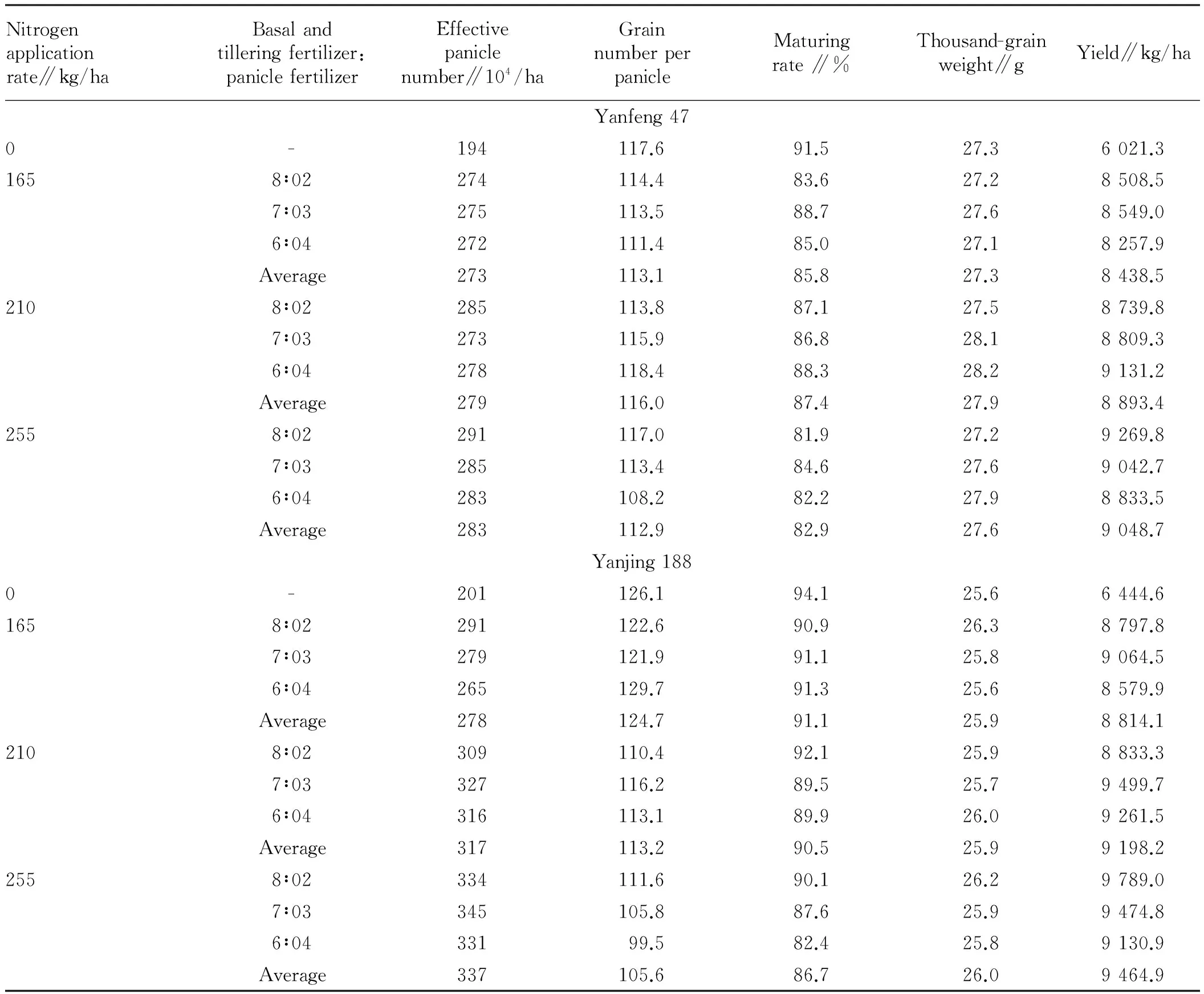
Nitrogenapplicationrate∥kg/haBasalandtilleringfertilizer:paniclefertilizerEffectivepaniclenumber∥104/haGrainnumberperpanicleMaturingrate∥%Thousand-grainweight∥gYield∥kg/haYanfeng470-194117.691.527.36021.31658∶02274114.483.627.28508.57∶03275113.588.727.68549.06∶04272111.485.027.18257.9Average273113.185.827.38438.52108∶02285113.887.127.58739.87∶03273115.986.828.18809.36∶04278118.488.328.29131.2Average279116.087.427.98893.42558∶02291117.081.927.29269.87∶03285113.484.627.69042.76∶04283108.282.227.98833.5Average283112.982.927.69048.7Yanjing1880-201126.194.125.66444.61658∶02291122.690.926.38797.87∶03279121.991.125.89064.56∶04265129.791.325.68579.9Average278124.791.125.98814.12108∶02309110.492.125.98833.37∶03327116.289.525.79499.76∶04316113.189.926.09261.5Average317113.290.525.99198.22558∶02334111.690.126.29789.07∶03345105.887.625.99474.86∶0433199.582.425.89130.9Average337105.686.726.09464.9
3.4EffectofdifferentnitrogenfertilizerapplicationstrategiesonnitrogenuserateAs can be seen from Table 4, with increasing application of fertilizer, the total nitrogen uptake of Yanfeng 47 shows an increasing trend; nitrogen harvest index and nitrogen recovery ratio show a decreasing trend; physiological nitrogen use efficiency first increases and then decreases. Under the pure nitrogen application treatment of 165 kg/ha, when the proportion of basal and tillering fertilizer and panicle fertilizer is 6∶ 4, the nitrogen harvest index and physiological nitrogen use efficiency can be increased; when the proportion is 7∶3, the nitrogen recovery ratio, nitrogen harvest index and total nitrogen uptake can be increased; when the proportion is 8∶2, nitrogen use efficiency is not dominant. Under the pure nitrogen application treatment of 210 kg/ha, when the proportion of basal and tillering fertilizer and panicle fertilizer is 6∶ 4, the nitrogen recovery ratio and total nitrogen uptake can be increased; when the proportion is 7∶3, the nitrogen use rate is in a middle state; when the proportion is 8∶2, the nitrogen harvest index and physiological nitrogen use efficiency can be increased. Under the pure nitrogen application treatment of 255 kg/ha, when the proportion of basal and tillering fertilizer and panicle fertilizer is 6∶ 4, the physiological nitrogen use efficiency is high, but the other nitrogen use rates are low; when the proportion is 7∶3, the nitrogen recovery ratio, total nitrogen uptake and nitrogen harvest index can be increased; when the proportion is 8∶2, the physiological total nitrogen use efficiency can be improved. With increasing application of fertilizer, the total nitrogen uptake of Yanjing 188 shows an increasing trend; nitrogen harvest index and nitrogen recovery ratio first increase and then decrease; physiological nitrogen use efficiency shows a decreasing trend. Under the pure nitrogen application treatment of 165 kg/ha, when the proportion of basal and tillering fertilizer and panicle fertilizer is 6∶ 4, the nitrogen recovery ratio and total nitrogen uptake can be increased; when the proportion is 7∶3, the nitrogen use rate is in a middle state; when the proportion is 8∶2, the nitrogen harvest index and physiological nitrogen use efficiency can be increased. Under the pure nitrogen application treatment of 210 kg/ha, when the proportion of basal and tillering fertilizer and panicle fertilizer is 6∶ 4, the nitrogen harvest index and total nitrogen uptake are in a middle state; the nitrogen harvest index and physiological nitrogen use efficiency are very low; when the proportion is 7∶3, the total nitrogen uptake and nitrogen recovery ratio can be increased; when the proportion is 8∶2, the physiological nitrogen use efficiency and nitrogen harvest index can be increased. Under the pure nitrogen application treatment of 255 kg/ha, when the proportion of basal and tillering fertilizer and panicle fertilizer is 6∶ 4, the total nitrogen uptake and nitrogen recovery ratio can be increased, and the physiological nitrogen use efficiency and nitrogen harvest index can be decreased; when the proportion is 7∶3, the physiological nitrogen use efficiency and nitrogen harvest index are in a middle state, and the total nitrogen uptake and nitrogen recovery ratio are very low; when the proportion is 8∶2, the physiological nitrogen use efficiency and nitrogen harvest index can be increased.
Table4Effectofdifferentnitrogenfertilizerapplicationstrategiesonnitrogenuserate
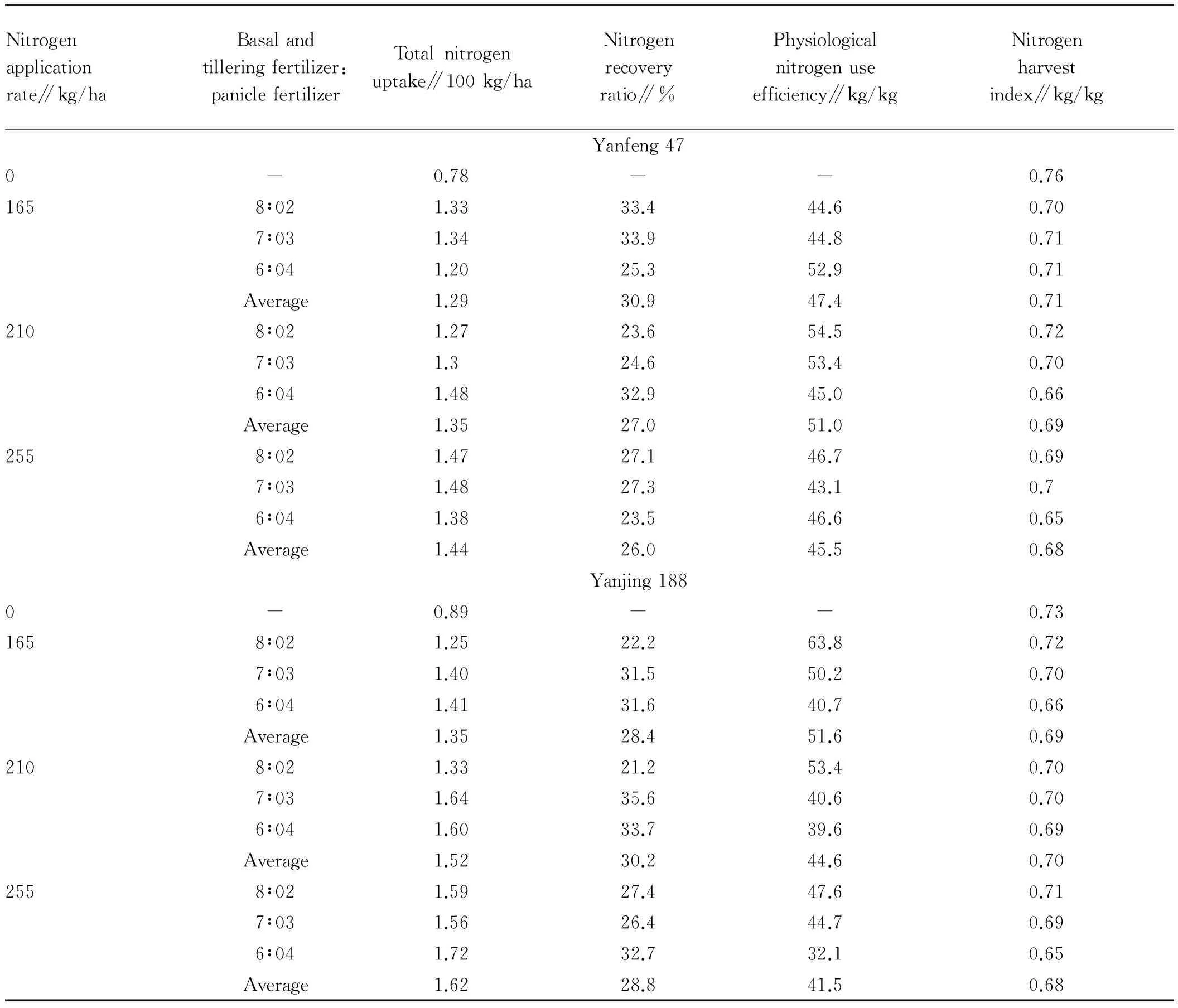
Nitrogenapplicationrate∥kg/haBasalandtilleringfertilizer:paniclefertilizerTotalnitrogenuptake∥100kg/haNitrogenrecoveryratio∥%Physiologicalnitrogenuseefficiency∥kg/kgNitrogenharvestindex∥kg/kgYanfeng470-0.78--0.761658∶021.3333.444.60.707∶031.3433.944.80.716∶041.2025.352.90.71Average1.2930.947.40.712108∶021.2723.654.50.727∶031.324.653.40.706∶041.4832.945.00.66Average1.3527.051.00.692558∶021.4727.146.70.697∶031.4827.343.10.76∶041.3823.546.60.65Average1.4426.045.50.68Yanjing1880-0.89--0.731658∶021.2522.263.80.727∶031.4031.550.20.706∶041.4131.640.70.66Average1.3528.451.60.692108∶021.3321.253.40.707∶031.6435.640.60.706∶041.6033.739.60.69Average1.5230.244.60.702558∶021.5927.447.60.717∶031.5626.444.70.696∶041.7232.732.10.65Average1.6228.841.50.68
4 Conclusions and discussions
4.1ConclusionsNitrogen fertilizer and its application methods are important factors affecting the growth and yield of rice, however, the current use of nitrogen fertilizer for rice is too high, and the proportion of nitrogen fertilizer is very large in the early period. Using former nitrogen moved backward (FNMB) and precise fertilization technique for rise, this paper studies and optimizes the nitrogen application strategies for rice cultivars in the specific ecological zones, and clarifies the regulatory mechanisms of different nitrogen fertilizer application strategies on rice production, in order to provide scientific basis for improving nitrogen use efficiency and sustainable development of rice. The dry matter accumulation and distribution, yield and quality are studied to understand the formation of yield and quality of rice under different nitrogen application strategies. The result indicates that former nitrogen moved backward (FNMB) can increase tiller number and dry matter accumulation; effective panicle and yield can be increased with the increase of fertilization; rational nitrogen application can help to establish scientific group structure, harmonize yield component, and then achieve high ratio of input to output and benefit.
4.2Discussions
(i) Many scholars at home and abroad have conducted in-depth research on how to improve fertilizer efficiency, and generally believe that the nitrogen fertilizer use rate will significantly decrease with the increasing nitrogen application, and unreasonable nitrogen application strategies will also cause the decline in farm productivity and nitrogen use efficiency[7]. In this study, two rice varieties obtain suitable effective panicles under the pure nitrogen application treatment of 210 kg/ha, when the proportion of basal and tillering fertilizer and panicle fertilizer is 6∶ 4 and 7∶3, suggesting that the suitable backward-moving application of nitrogen can help to establish a more rational group structure and harmonize yield components. In paddy ecosystems, nitrogen is a major driving force for rice production, and how to rationally apply nitrogen fertilizer has been an important research topic in rice cultivation systems[8]. Therefore, reasonably applying nitrogen fertilizer and improving nitrogen use efficiency is a major study subject for scientists[9]. In this study, it is concluded that former nitrogen moved backward (FNMB) will improve total nitrogen uptake and nitrogen recovery ratio. (ii) China's rice planting area accounts for 20% of the world's rice planting area, but the consumption of rice nitrogen fertilizer accounts for 37% of total consumption of rice nitrogen fertilizer in the world. Farmers have long entertained the misconception that more fertilizers will lead to higher yield. In addition, the relatively low nitrogen fertilizer prices also lead to excessive application of nitrogen fertilizer[10], so that the proportion between fertilizer input and grain output is much higher than the world average, and China becomes the world's first major fertilizer consuming country[11]. In this study, it is found that different rice varieties have different reaction to nitrogen application, and nitrogen application also has some negative effects. (iii) The main reasons for low fertilizer use efficiency in China include neglect of soil nutrient use, excessive fertilization, inadequate tapping of crop yield potential, and numerous sources of environmental nutrients[12]. Scientific and technical personnel use different fertilization methods to guide rice production and achieve some results[13]. Given the different habits of nitrogen fertilizer application, the rice researchers need to create efficient management model of rice nitrogen fertilizer to reduce pests and diseases, improve rice quality and enhance nitrogen fertilizer use efficiency while ensuring the existing rice yields[14]. It is of important strategic significance to improving rice production competitiveness and guaranteeing national food security[15].
[1] YU GP, ZHU HY. Study on the current situation and development countermeasures of rice production in China[J].Modern Agricultural Science and Technology,2009(6):122-126.(in Chinese).
[2] GUO L, LIANG TF, TANG MY,etal. Plant growth and nitrogen utilization of the system of rice intensification under different fertilization patterns and tillage ways [J].Chinese Agricultural Science Bulletin,2007, 23(1):185-188.(in Chinese).
[3] YANG ZM, WANG WJ, CAI ML,etal. Effects of applying time and quantity of nitrogen fertilizer on rice quality[J].Journal of Huazhong Agricultural University,2002, 21(5):429-434.(in Chinese).
[4] WANG SH. On operational fertilization of nitrogen in rice[J].Modernizing Agriculture,2008(6):14-15.(in Chinese).
[5] YE M, YAO YP, SHI YH,etal. Exploration on the reasonable application and planning and management techniques of rice nitrogen fertilizer[J].Shanghai Agricultural Science and Technology,2002(6):21-22.(in Chinese).
[6] LIU LJ, SANG DZ, LIU CL,etal. Effects of real-time and site-specific nitrogen managements on rice yield and nitrogen use efficiency[J].Scientia Agricultura Sinica,2003, 36(12):1456-1461.(in Chinese).
[7] WANG XQ, ZHANG HC, HUANG YZ,etal. Effects of N-application rate on the characters of uptake nitrogen and nitrogen recovery of different rice varieties[J].Journal of Shanghai Jiaotong University (Agricultural Science),2003, 21(4):325-330.(in Chinese).
[8] LI GS, ZHANG H, WANG ZQ,etal. Effects of nitrogen levels on grain yield and quality of rice[J].Journal of Yangzhou University:Agricultural and Life Science Edition,2007(4):66-70.(in Chinese).
[9] LU FY, WANG LG, QIN HD,etal. Effects of nitrogen and silicon levels on grain yield and qualities of rice[J].Plant Nutrition and Fertilizer Science,2005, 11(6):846-850.(in Chinese).
[10] ZHANG Y, MA SX, WANG QJ,etal. Effect of nitrogen fertilizer amount on yield and quality in rice[J].Reclaiming and Rice Cultivation,2009(5):16-18.(in Chinese).
[11] ZHANG ZF, ZHANG WF. The situation and trend of fertilizer application in China[J].Phosphate & Compound Fertilizer,2008,23(6):9-12.(in Chinese).
[12] YANG QL, SANG LM, SUN JR,etal. Current situation of fertilizer use in China and the method to improve chemical fertilizer utilization efficiency[J].Journal of Shanxi Agricultural Sciences,2011, 39(7):690-692.(in Chinese).
[13] HU JL, WANG DJ, WANG C,etal. Effect of different fertilization systems on rice yield components and their stability[J].Chinese Journal of Eco-Agriculture,2009,17(1):48-53.(in Chinese).
[14] LUO ZX. Ways for improving nitrogen use efficiency[J].Modern Agricultural Science and Technology, 2011(2):306.(in Chinese).
[15] TANG H, LI JM, SONG WP,etal. Strategic thought on enhancing competitiveness of Hunan rice industry[J].Journal of Beijing Agricultural College,2008, 23(3):61-65.(in Chinese).
November 10, 2015 Accepted: January 10, 2016
*Corresponding author. E-mail: carredags@126.com
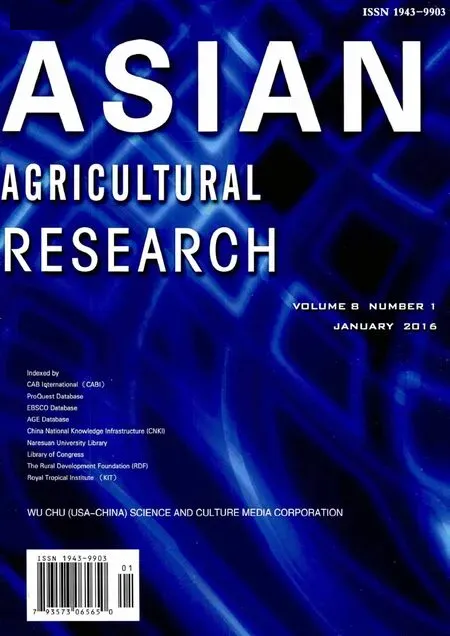 Asian Agricultural Research2016年1期
Asian Agricultural Research2016年1期
- Asian Agricultural Research的其它文章
- Application and Residue Pollution of Mulching Films in Xinjiang
- Resource Dependence Relationship between Grass-roots Government and Farmers’ Specialized Cooperatives
- Urban Residents’ Consumption Risk Perception about the Dairy Products
- Study on the Aromatic Components of Green Plum Wine by HS-SPME-GC-MS
- Effect of Vacuum Packaging on Storage Quality of Peanut
- Innovative Development of Fishery and Ecological Protection of Poyang Lake
